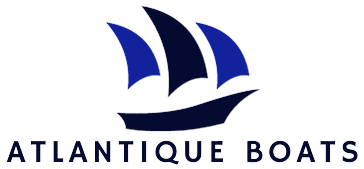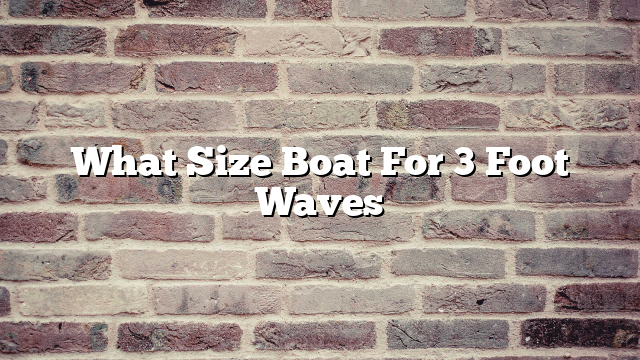Are you a passionate sailor, eager to conquer the thrilling ocean waves? Or perhaps you’re a beginner, excited to dip your toes into the world of boating? Whichever category you fall into, one question that often arises is, “What size boat is suitable for navigating 3-foot waves?” As a professional writer and fellow enthusiast, I’m here to explore this topic with you in English, providing you with valuable insights and guidance.
Picture this: a sun-kissed horizon, the wind gently caressing your face, and the rhythmic sound of waves crashing against your boat. But wait, how do you ensure a smooth and safe adventure amidst those 3-foot swells? The choice of boat size becomes crucial. In this article, we will delve into the factors to consider when selecting the right vessel to handle such waves, exploring the characteristics and capabilities that will guarantee stability, control, and, most importantly, your peace of mind.
Join me as we embark on a journey to demystify the complexities of boat size and wave navigation. Whether you’re a seasoned sailor seeking to upgrade your vessel or a curious beginner looking to make an informed decision, this discussion will equip you with the knowledge needed to confidently choose the perfect boat size for conquering the magnificent 3-foot waves. So, tighten your life jacket and prepare for an exciting exploration of the sea!
In general, a boat between 16 and 20 feet long is recommended for handling 3-foot waves. However, the size of the boat also depends on factors such as hull design, weight, and construction. It’s essential to consider the boat’s seaworthiness, stability, and the experience of the captain and crew when determining the appropriate boat size for such conditions.
What Size Boat is Suitable for 3 Foot Waves
When it comes to boating in waves, the size of the boat plays a crucial role in ensuring a safe and comfortable ride. Waves can be unpredictable and can pose a risk to smaller boats that are not designed to handle rough conditions. In this article, we will guide you through the steps to determine the appropriate size boat for navigating 3-foot waves.
Step 1: Understanding Wave Heights
Before choosing the right boat size, it is important to have a clear understanding of wave heights. Waves are measured from the trough (bottom) to the crest (top) and are usually reported in feet or meters. A 3-foot wave refers to the distance from the lowest point to the highest point of the wave. This size of wave is considered moderate and can be navigated by boats of various sizes, depending on their design and capabilities.
However, it is essential to note that wave heights can vary based on factors such as wind speed, water depth, and the duration of the wave. It is crucial to stay updated with weather forecasts and consult local boating experts for accurate information regarding wave conditions in your area.
Step 2: Boat Length and Hull Design
When determining the appropriate boat size for navigating 3-foot waves, the length of the boat and its hull design are key factors to consider. Generally, boats with longer lengths tend to handle waves better than smaller ones. This is because longer boats have more surface area in contact with the water, providing better stability and control.
In addition to length, the hull design is crucial for wave handling. Boats with deep-V hulls are known for their excellent wave-handling capabilities. The V-shaped hull cuts through waves and helps to distribute the impact evenly, providing a smoother ride. Flat-bottomed boats, on the other hand, are more suitable for calm waters and may struggle to navigate through 3-foot waves.
Step 3: Weight and Displacement
Another important factor to consider is the weight and displacement of the boat. Heavier boats tend to handle waves better as they have more stability and are less affected by wave forces. Lighter boats, especially those with a high center of gravity, are more prone to tipping or getting tossed around by waves.
When selecting a boat, pay attention to its maximum recommended weight capacity and ensure that it can handle the weight of passengers, equipment, and supplies. It is essential to distribute the weight evenly to maintain stability and optimize wave-handling capabilities.
Step 4: Power and Engine Size
The power and engine size of the boat also play a significant role in wave navigation. Boats with sufficient power and appropriately sized engines can better handle waves. Underpowered boats may struggle to maintain control and stability in rough conditions.
When considering the power and engine size, factors such as the boat’s weight, intended use, and the number of passengers should be taken into account. Consult the boat’s manufacturer or a knowledgeable marine professional to determine the appropriate power and engine specifications for navigating 3-foot waves.
Step 5: Safety Equipment and Training
Regardless of the size of the boat, it is crucial to prioritize safety when boating in waves. Equip your boat with essential safety gear, including life jackets, flares, a first aid kit, and a radio for communication. Additionally, ensure that you and your passengers receive proper training in boating safety and wave navigation techniques.
By following these steps and considering various factors such as wave heights, boat length and hull design, weight and displacement, power and engine size, and safety equipment, you can determine the appropriate size boat for navigating 3-foot waves. Remember to always exercise caution, stay informed about weather conditions, and seek expert advice when necessary.
Frequently Asked Questions
Here are some commonly asked questions about choosing the right size boat for 3-foot waves:
Question 1: What size boat is suitable for 3-foot waves?
When it comes to navigating 3-foot waves, it is recommended to use a boat that is at least 20 feet in length. This size provides better stability and control, allowing you to handle the waves more comfortably and safely. Smaller boats may struggle to maintain stability and could be more prone to capsizing in such conditions.
Additionally, it is important to consider the type of boat you are using. A boat with a deep V-shaped hull is better suited for handling waves, as it cuts through the water more effectively and provides a smoother ride.
Question 2: Can a smaller boat handle 3-foot waves?
While it is possible for smaller boats to handle 3-foot waves, they may not provide the same level of stability and control as larger boats. Smaller boats, such as those under 20 feet in length, may experience more rocking and pitching in these conditions, making them less ideal for rougher waters.
If you plan to frequently navigate 3-foot waves or encounter rougher conditions, it is advisable to opt for a larger boat that can provide a more comfortable and safer experience.
Question 3: Are there any specific boat features to consider for handling 3-foot waves?
When selecting a boat for 3-foot waves, there are a few important features to consider. Firstly, a boat with a deep V-shaped hull is highly recommended, as it offers better stability and improved handling in rougher waters. The deeper the V-shape, the better the boat will be able to cut through the waves.
Additionally, boats with self-bailing cockpits are beneficial, as they help to quickly drain any water that may enter the boat during wave impacts. This ensures that the boat remains buoyant and reduces the risk of swamping.
Question 4: Is it necessary to have a larger engine for navigating 3-foot waves?
Having a larger engine can be advantageous when navigating 3-foot waves. A more powerful engine provides better control and maneuverability, allowing you to adjust your speed and direction more effectively in response to the waves. It can also help the boat maintain stability and reduce the risk of being overwhelmed by the waves.
However, it is important to ensure that the boat’s engine is suitable for its size and weight. Consulting with a marine expert or boat manufacturer can help determine the ideal engine size for your specific boat and wave conditions.
Question 5: What safety precautions should be taken when navigating 3-foot waves?
When navigating 3-foot waves, it is crucial to prioritize safety. Firstly, ensure that all passengers on board are wearing properly fitted life jackets. This is essential in case of an unexpected capsize or fall overboard.
Additionally, regularly check the weather conditions and wave forecasts before heading out. If the wave conditions are expected to exceed the capabilities of your boat, it is advisable to postpone your trip or seek an alternative route.
Lastly, maintain a safe speed and avoid sudden maneuvers. Slow and steady navigation is key to maintaining control and stability when facing waves.
In conclusion, determining the appropriate size of boat for navigating 3-foot waves is a crucial consideration for any avid sailor or water enthusiast. While there is no definitive answer, as it depends on various factors such as boat type, experience level, and intended use, it is essential to prioritize safety and comfort on the water.
When selecting a boat, it is important to choose one that can handle the size and intensity of the waves typically encountered. A larger boat with a deep V-hull design may provide better stability and a smoother ride, ensuring a more enjoyable experience in moderate wave conditions. Additionally, considering the weight and displacement of the boat is vital, as a heavier vessel can better handle the impact of the waves and provide a more stable platform.
However, it is crucial to remember that boat size alone is not the sole determinant of handling rough water conditions. Equally important is the operator’s experience and skill in maneuvering through waves. Adequate training and knowledge of proper boating techniques are paramount to safely navigating any size of waves.
Ultimately, when it comes to deciding the appropriate boat size for 3-foot waves, it is recommended to consult with experts in the boating industry or experienced sailors who can provide valuable insights. By considering the factors mentioned above and prioritizing safety above all else, individuals can make informed decisions that will enhance their enjoyment of the water while minimizing risks. So, whether you choose a smaller vessel or opt for a larger, more stable boat, always prioritize safety, and enjoy the thrill of exploring the waves in a suitable and well-equipped vessel.


















